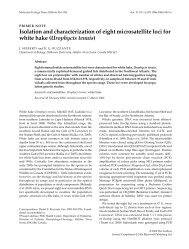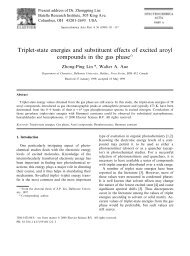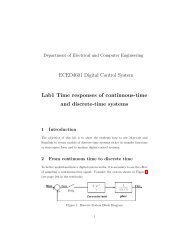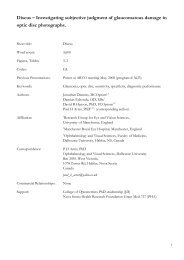Perceived Social Support and Academic Achievement: Cross ...
Perceived Social Support and Academic Achievement: Cross ...
Perceived Social Support and Academic Achievement: Cross ...
You also want an ePaper? Increase the reach of your titles
YUMPU automatically turns print PDFs into web optimized ePapers that Google loves.
Running Head: SOCIAL SUPPORT AND ACADEMIC ACHIEVEMENT<br />
<strong>Perceived</strong> <strong>Social</strong> <strong>Support</strong> <strong>and</strong> <strong>Academic</strong> <strong>Achievement</strong>:<br />
<strong>Cross</strong>-lagged Panel <strong>and</strong> Bivariate Growth Curve Analyses<br />
Sean P. Mackinnon<br />
Dalhousie University<br />
Author Note<br />
Sean P. Mackinnon, Department of Psychology, Dalhousie University, Halifax, Nova<br />
Scotia, Canada.<br />
Correspondence concerning this article should be addressed to Sean P. Mackinnon,<br />
Department of Psychology, Dalhousie University, Life Sciences Centre, 1459 Oxford Street<br />
Halifax, Nova Scotia, Canada, B3H 4R2. E-mail: mackinnon.sean@gmail.com, Phone: (902)<br />
494-7719, Fax: (902) 494-6585.
NOTICE: This is the author‘s version of a work accepted for publication by Springer. The<br />
original publication is available at www.springerlink.com.<br />
Mackinnon, S. P. (in press). <strong>Perceived</strong> social support <strong>and</strong> academic achievement: <strong>Cross</strong>-lagged<br />
panel <strong>and</strong> bivariate growth curve analyses. Journal of Youth <strong>and</strong> Adolescence. doi:<br />
10.1007/s10964-011-9691-1<br />
2
Abstract<br />
As students transition to post-secondary education, they experience considerable stress <strong>and</strong><br />
declines in academic performance. <strong>Perceived</strong> social support is thought to improve academic<br />
achievement by reducing stress. Longitudinal designs with three or more waves are needed in<br />
this area because they permit stronger causal inferences <strong>and</strong> help disentangle the direction of<br />
relationships. This study uses a cross-lagged panel <strong>and</strong> a bivariate growth curve analysis with a<br />
three-wave longitudinal design. Participants include 10,445 students (56% female; 12.6% born<br />
outside of Canada) transitioning to post-secondary education from ages 15-19. Self-report<br />
measures of academic achievement <strong>and</strong> a generalized measure of perceived social support were<br />
used. An increase in average relative st<strong>and</strong>ing in academic achievement predicted an increase in<br />
average relative st<strong>and</strong>ing on perceived social support two years later, but the reverse was not<br />
true. High levels of perceived social support at age 15 did not protect against declines in<br />
academic achievement over time. In sum, perceived social support appears to have no bearing on<br />
adolescents’ future academic performance, despite commonly held assumptions of its<br />
importance.<br />
Key words: academic achievement; grades; social support; gender; immigrant; longitudinal;<br />
adolescent;<br />
3
<strong>Social</strong> support is positively correlated with academic achievement in adolescents <strong>and</strong><br />
emerging adults (e.g., Robbins, Lauber, Le, Davis, Langley & Carlstrom, 2004). It is typically<br />
assumed that social support leads to increased academic achievement <strong>and</strong> most studies are<br />
designed with this theoretical assumption in mind (e.g., Cutrona, Cole, Colangelo, Assouline &<br />
Russell, 1994; DeBerad, Spielmans, & Julka, 2004). Longitudinal designs with three or more<br />
waves allow for stronger causal inferences <strong>and</strong> help disentangle the direction of relationships<br />
between two variables. These designs are a significant improvement over cross-sectional designs<br />
<strong>and</strong> allow researchers to test rival hypotheses, where academic achievement predicts change in<br />
social support. These rival hypotheses are consistent with the literature on self-esteem <strong>and</strong><br />
academic achievement, which finds that self-esteem is an outcome, rather than an antecedent of<br />
academic achievement (Baumeister, Campbell, Krueger <strong>and</strong> Vohs, 2003). This study seeks to<br />
disentangle the direction of the relationship between academic achievement <strong>and</strong> perceived social<br />
support using a three-wave longitudinal design following students from age 15 to age 19. The<br />
longitudinal relationship between these variables has important pedagogical <strong>and</strong> policy<br />
implications for educators interested in improving academic performance in adolescents.<br />
<strong>Social</strong> support <strong>and</strong> academic achievement<br />
Lakey <strong>and</strong> Cohen (2000) identify two dimensions of social support: Received social<br />
support (i.e., frequency of supportive actions from others, such as advice <strong>and</strong> reassurance) <strong>and</strong><br />
perceived social support (i.e., perceptions of how much social support one has available, if it<br />
were necessary). In this article, only perceived social support was examined. Theory on stress<br />
<strong>and</strong> coping suggests the cognitive interpretation of negative events (e.g., failing a test) plays a<br />
large role in how stressful those events will be (Lazarus & Folkman, 1984). <strong>Perceived</strong> social<br />
support is associated with more positive appraisals of one’s ability to cope with negative events.<br />
4
The transition from high school to post-secondary education is a highly stressful time for<br />
many adolescents. This transition period is associated with numerous stressors, including social<br />
isolation, academic pressure, financial difficulties <strong>and</strong> homesickness (Fisher & Hood, 1987).<br />
Such stressors contribute to heightened psychological distress, anxiety, depression, <strong>and</strong> health<br />
problems (Hicks & Heastie, 2008). The psychological distress associated with the transition to<br />
post-secondary education has a strong, negative effect on the academic achievement <strong>and</strong> post-<br />
secondary retention for freshman students (Hysenbegasi, Hass & Rowl<strong>and</strong>, 2005). It is<br />
frequently assumed that increasing social support will serve as a buffer against these stressors. In<br />
this way, perceived social support is thought to contribute to improved academic performance<br />
distally by decreasing the stress of academic life (Lakey & Cohen, 2000).<br />
Indeed, the positive relationship between perceived social support <strong>and</strong> academic<br />
achievement has been frequently demonstrated. <strong>Cross</strong>-sectional research suggests there is a<br />
positive correlation between perceived social support <strong>and</strong> grade point averages in high school<br />
(Domagala-Zysk, 2006; Rosenfeld, Richman & Bowen, 2000) with support from parents<br />
emerging as one of the most important sources of social support (Bahar, 2010; Rueger, Malecki,<br />
& Demaray, 2010). A meta-analysis of 33 studies (N = 12,366) found a positive correlation<br />
between perceived social support <strong>and</strong> Grade Point Average in post-secondary education<br />
(Robbins et al., 2004). Though the effect size was relatively small in this meta-analysis (r =<br />
.106), this cross-sectional relationship remains robust across studies with sufficient power to<br />
detect it. Though the cross-sectional relationship between social support <strong>and</strong> academic<br />
achievement is clear, the direction of this relationship remains contested. In order to make<br />
stronger causal inferences about directionality, longitudinal research – ideally with three or more<br />
measurement occasions – is required. Longitudinal research has many statistical benefits,<br />
5
including the ability to control for base rates of variables <strong>and</strong> the ability to test reciprocal<br />
relationships (Curran, 2000). In the section that follows, a review of the longitudinal research<br />
examining the link between perceived social support <strong>and</strong> academic achievement is provided.<br />
Longitudinal Research<br />
Some prospective longitudinal research suggests social support predicts improvements in<br />
academic achievement over time. Cutrona et al. (1994) found that parental support – but not peer<br />
support – predicted future academic achievement, over <strong>and</strong> above baseline levels of academic<br />
ability. Another study found that peer <strong>and</strong> parental support longitudinally predicted positive<br />
academic behaviours (e.g., studying), though this relationship eroded as parental education<br />
decreased (Purswell, Yazedjian, & Toews, 2008). DeBerad et al. (2004) found that perceived<br />
social support uniquely predicted future academic achievement over <strong>and</strong> above a wide variety of<br />
other variables, including high school GPA, smoking <strong>and</strong> coping behaviours. Together, these<br />
studies support the notion that social support predicts higher grades in the future.<br />
However, other lines of longitudinal research suggest that social support does not<br />
improve academic achievement. Grayson (2003) showed that early adjustment at university –<br />
which includes social support – has no impact on academic success in a Canadian sample.<br />
Dubois, Felner, Br<strong>and</strong>, Adan <strong>and</strong> Evans (1992) found that perceived social support from family,<br />
friends <strong>and</strong> school could not predict future grade-point average over <strong>and</strong> above prior levels of<br />
academic achievement <strong>and</strong> negative life events. Nicpon, Huser, Blanks, Sollenberger, Befort &<br />
Kurpius (2006) did not control for base rates of academic performance, but did find that<br />
perceived social support from family <strong>and</strong> friends was unrelated to future grade point average.<br />
The findings in the longitudinal literature on perceived social support <strong>and</strong> academic achievement<br />
are thus inconsistent.<br />
6
All of the longitudinal studies reviewed above assumed social support led to increased<br />
academic performance. This was reflected in their analytic approach, which was typically<br />
regression-based with social support as a predictor <strong>and</strong> grade point average as the outcome.<br />
Given the inconsistencies in the longitudinal research, might it be that the assumed direction of<br />
causality is wrong? This would be consistent with research suggesting that students – particularly<br />
students from Chinese immigrant families – often feel parental support is contingent on<br />
performing well in school (e.g., Costigan, Hua & Su, 2010). Baumeister et al. (2003) have<br />
convincingly argued that general self-esteem is a consequence – but not a cause – of academic<br />
achievement (c.f. Marsh & Craven, 2006 for a counterpoint). The relationship between perceived<br />
social support <strong>and</strong> academic achievement might be similar; getting good grades might actually<br />
lead to perceptions of social support. Virtually no studies have tested this rival hypothesis against<br />
the theory that high social support leads to better grades. This article addresses this gap by<br />
conducting multi-wave longitudinal analyses which test for both possibilities simultaneously,<br />
thus providing a more stringent test of directionality.<br />
Gender differences<br />
There are some key gender differences in prior research. Governmental reports in Canada<br />
(Statistics Canada, 2008), the United States (Freeman, 2004) <strong>and</strong> the United Kingdom (Younger<br />
& Warrington, 2005) note that young boys may be “getting left behind” in the educational<br />
system, <strong>and</strong> highlight the need for interventions at the individual <strong>and</strong> institutional level. In<br />
particular, boys tend to score lower on verbal <strong>and</strong> writing skills than girls (Ma & Klinger, 2000).<br />
Though some research suggests that boys slightly outperform girls on st<strong>and</strong>ardized testing in<br />
mathematics, this gap has been narrowing <strong>and</strong> the effect size is small (Lauzon, 2001). Of course,<br />
there is a very apparent “glass ceiling” at the highest levels of graduate education; women<br />
7
account for only 44% of all doctorates awarded in Canada (Statistics Canada, 2008). However,<br />
when studying overall academic achievement of adolescents aged 15-19, boys are more likely to<br />
emerge as disadvantaged. Girls also tend to perceive more social support from their peers than<br />
boys (Bogard, 2005; Furman & Buhrmester; Nicpon et al., 2006). This is likely due to gender<br />
differences in the way that girls approach relationships; girls tend to form a few close,<br />
empathetic relationships high in mutual disclosure, whereas boys tend to have larger, more<br />
extended friendship groups focused on tasks, competition <strong>and</strong> conflict (De Goede, Branje, &<br />
Meeus, 2009). On average, girls tend to have higher mean levels of academic achievement <strong>and</strong><br />
perceived social support than boys.<br />
There is also evidence suggesting that girls utilize social support in different ways then<br />
boys. Bogard (2005) found that social support from peers is associated with lower levels of<br />
depression, but only for boys. Altermatt (2007) found that increased social support from peers<br />
<strong>and</strong> family members after an academic failure tended to increase academic worry for girls, but<br />
not boys. Rueger et al. (2010) found that classmate social support was a predictor of academic<br />
performance for boys, but not for girls. Together, these results suggest that boys utilize peer<br />
social support in ways more conductive to improved academic performance than girls. Based on<br />
these results, it seems reasonable to expect that the relationship between social support <strong>and</strong><br />
academic achievement would be stronger for boys than for girls.<br />
Immigrant status differences<br />
Immigrants to Canada may have systematic differences in their levels of social support<br />
<strong>and</strong> their academic performance. Intergenerational relations of immigrant families are less<br />
harmonious than those of non-immigrant families, which suggests lower family social support<br />
(Kwak, 2003). Moreover, sheer physical distance from one’s family may be a particular concern<br />
8
for international students. Nevertheless, academic performance of immigrants is comparable or<br />
better than Canadian-born students, overall. Immigrant children sometimes experience initial<br />
difficulties in reading <strong>and</strong> writing, but this difference disappears – or even reverses – as the<br />
students spend more time in the Canadian education system (Worswick, 2001). Immigrant<br />
students also tend to score higher in mathematics both in Canada (Areepattamannil & Freeman,<br />
2008) <strong>and</strong> in the United States (Glick <strong>and</strong> White, 2003). Together, these results suggest that<br />
immigrants have lower levels of perceived social support, but are roughly equivalent in overall<br />
academic performance when compared to Canadian citizens. There is no strong evidence to<br />
support immigrant status as a moderator; social support appears to be equally important for both<br />
Canadian-born <strong>and</strong> immigrant students (Grayson, 2008).<br />
Moving away from home<br />
Evidence from qualitative (Wilcox, Winn & Fyvie-Gauld, 2005) <strong>and</strong> quantitative (Raviv,<br />
Keinan, Abazon, & Raviv, 1990) studies suggest that social support networks are greatly<br />
disrupted for students who move away from their parental home. Given the strong correlation<br />
between parental support <strong>and</strong> academic achievement as found in meta-analyses (e.g., Fan &<br />
Chen, 2001), it seems likely that students who move away from their parental home will<br />
experience decreases in their levels of academic achievement. However, there is also evidence<br />
suggesting that students who live on-campus have greater access to academic supports, have<br />
higher GPAs, <strong>and</strong> show increased academic persistence (e.g., Nicpon et al., 2006). Given the<br />
contradictory evidence, the potential role of living arrangements is currently unclear. Thus,<br />
whether or not students have moved away from their family home is included as an exploratory<br />
variable, without specific hypotheses.<br />
The present research <strong>and</strong> hypotheses<br />
9
Research questions are limited by the statistical procedures used. In this article, a cross-<br />
lagged panel analysis <strong>and</strong> a bivariate growth curve model are used to examine changes in social<br />
support <strong>and</strong> academic achievement over time (see Curran, 2000). A cross-lagged panel measures<br />
change in average relative st<strong>and</strong>ing. A bivariate growth curve measures within-person change<br />
over time. Though each model conceptualizes change differently, both models allow researchers<br />
to make stronger causal inferences when compared to cross-sectional data, <strong>and</strong> both allow for bi-<br />
directional relationships. These two statistical models are used to test hypotheses 1, 4 <strong>and</strong> 5.<br />
Gender <strong>and</strong> immigrant status differences are proposed in hypotheses 2 <strong>and</strong> 3. Each hypothesis is<br />
listed below. Higher average relative st<strong>and</strong>ing on perceived social support will predict higher<br />
average relative st<strong>and</strong>ing on academic achievement two years later, after controlling for prior<br />
levels of academic achievement (H1). Significant gender differences will emerge. Girls will have<br />
higher mean levels of social support <strong>and</strong> academic achievement than boys. In addition, the<br />
positive relationship between academic achievement <strong>and</strong> perceived social support will be greater<br />
for boys than for girls (H2). Significant differences based on immigrant status will emerge.<br />
Specifically, immigrants will have higher mean levels of social support compared to Canadian<br />
citizens. No moderation by immigrant status is expected (H3). <strong>Academic</strong> achievement will tend<br />
to decrease over time as students transition from high school to post-secondary education (H4).<br />
A higher level of perceived social support at age 15 will predict a less pronounced drop in<br />
academic achievement in students transitioning to post-secondary education (H5).<br />
The above hypotheses are the most logical predictions based on prior theory suggesting<br />
that social support indirectly improves academic performance by reducing the stress of post-<br />
secondary transition (Lakey & Cohen, 2000), that boys <strong>and</strong> girls perceive <strong>and</strong> utilize social<br />
support in different ways (e.g., Rueger et al., 2010), <strong>and</strong> that immigrant children often have<br />
10
disharmonious family relationships because of joint pressures to conform to both Canadian <strong>and</strong><br />
their family’s cultural beliefs (e.g., Kwak, 2003). Whether or not students have moved away<br />
from their family home is included as an exploratory variable, but there is insufficient research<br />
currently available to generate theory-driven hypotheses for this variable. The statistical models<br />
employed in this article are open to the possibility of rival hypotheses where academic<br />
achievement leads to changes in perceived social support (e.g., Baumeister et al., 2003).<br />
Hypotheses are thus theory-driven, but data analysis remains open to the possibility that<br />
theoretical revision is needed.<br />
Participants<br />
Method<br />
Participants included people born in 1984 who were attending any form of schooling in<br />
Canada during the 1999/2000 school year. Data were acquired from a Statistics Canada dataset<br />
(Youth in Transition Survey). This longitudinal research had an initial sample size of 29,687 at<br />
the first measurement occasion. Cycle 1 occurred in the year 2000, <strong>and</strong> subsequent cycles<br />
occurred every two years. Only cycles 1 (age 15), 2 (age 17), <strong>and</strong> 3 (age 19) were analyzed. A<br />
sub-sample of participants (N = 10,445) who transitioned to university for the first time at either<br />
age 18 (n = 6262) or age 19 (n = 4183) was used. This subsample was selected to ensure that all<br />
participants in the sample were undergoing the same developmental transition to post-secondary<br />
education. This subsample was 56.0% female, 18.3% had moved away from their parental home<br />
permanently by age 19 <strong>and</strong> 12.6% were born outside Canada. Students’ median income from all<br />
sources at Cycle 1 was $8232. Weighted data can be considered nationally representative of<br />
students who attend post-secondary education at age 18 or 19.<br />
Procedure<br />
11
The survey population was created by selecting a r<strong>and</strong>om sample of schools in Canada,<br />
then selecting a systematic equal-probability sample of no more than 35 students from each<br />
school. This created a hierarchical sampling design, with students nested within schools. Data<br />
were collected longitudinally across three cycles. During April <strong>and</strong> May of 2000 (age 15),<br />
students filled out a 30 minute pen-<strong>and</strong>-paper questionnaire which included information on<br />
transitions, education, employment <strong>and</strong> other background variables. In 2002 (age 17) <strong>and</strong> 2004<br />
(age 19) students completed similar questions via a 45-minute phone interview. For this article,<br />
only self-reported grades, perceived social support, gender, country of birth <strong>and</strong> living<br />
arrangement status variables were used. For an in-depth description of methodology <strong>and</strong><br />
sampling procedures, see the Statistics Canada website (Statistics Canada, 2011).<br />
Materials<br />
Demographic variables. Gender was measured as a dichotomous variable (i.e., male or<br />
female). Immigrant status was measured using a dichotomous variable representing the<br />
participants’ country of birth (i.e., whether or not the participant was born in Canada).<br />
Living arrangement status was determined with a single yes/no question at age 19: “Do you<br />
consider yourself to have moved out permanently from the home of your parents or guardians?”<br />
<strong>Perceived</strong> social support. <strong>Perceived</strong> social support was measured the same way across<br />
all three cycles using a modified short-form of the <strong>Social</strong> Provisions Scale originally developed<br />
by Cutrona <strong>and</strong> Russell (1987). This 6-item questionnaire was measured using a 4-point likert<br />
scale from 1 (strongly disagree) to 4 (strongly agree). Items included were (a) “If something<br />
went wrong, nobody would help me;” (b) I have family <strong>and</strong> friends who help me feel safe, secure<br />
<strong>and</strong> happy;” (c) “there is someone I trust whom I would turn to for advice if I were having<br />
problems;” (d) “there is no one I feel comfortable talking about problems with;” (e) “there is no<br />
12
one I feel close to;” (f) “there are people I can count on in times of trouble.” An item-response<br />
theory score was calculated using these 6 items, <strong>and</strong> the resulting score was st<strong>and</strong>ardized with a<br />
mean of 0 <strong>and</strong> a st<strong>and</strong>ard deviation of 1 using the entire YITS sample of N = 29,687. This scale<br />
had adequate alpha reliabilities across all three cycles (age 15 α = .84; age 17 α = .85; age 19 α =<br />
.86). The scale also displayed excellent construct validity (factor loadings ranged from .64 to<br />
.82), <strong>and</strong> criterion-based validity (the total score correlated .30 or higher with other measures of<br />
social support) across all three cycles (Statistics Canada, 2011).<br />
<strong>Academic</strong> achievement. <strong>Academic</strong> achievement was measured using self-reported<br />
grades. High school grades at ages 15 <strong>and</strong> 17 were measured on a 7-point scale ranging from 1<br />
(90% to 100%) to 7 (less than 50%). Age 19 grades were measured on a 6-point scale ranging<br />
from 1 (90% or above) to 6 (under 50%). At age 15, self-reported high school grades were<br />
measured by taking the average of four variables: English grade, science grade, math grade, <strong>and</strong><br />
overall grade. At age 17, self-reported high school grades were measured by taking the average<br />
of three variables: Math grade, language grade, <strong>and</strong> overall grade. At age 19, self-reported post-<br />
secondary grades were measured with a single variable: overall grade. All variables were<br />
converted from their initial numeric codes into numeric grades out of 100% to promote ease of<br />
interpretation (e.g., “90% or higher” was recoded to 95%). Meta-analysis shows that self-<br />
reported grades correlate highly with grades obtained from official academic records (90%<br />
credibility interval of .70 to .94), which suggests that self-reported grades are a reasonably valid<br />
way of measuring academic achievement (Kuncel, Credé & Thomas, 2005).<br />
Data analytic strategy<br />
Results<br />
13
Missing data analysis <strong>and</strong> tests of multivariate normality were conducted in SPSS 15.0<br />
software to assess how missing data should be h<strong>and</strong>led <strong>and</strong> whether or not a robust estimation<br />
procedure would be required. Descriptive statistics were calculated with sample weights derived<br />
by Statistics Canada to address over-sampling; descriptive statistics can thus be considered<br />
nationally representative. The remaining analyses were conducted with unweighted data.<br />
Because the complex sampling strategy created nested data (i.e., students nested within schools),<br />
a robust estimator of st<strong>and</strong>ard errors using the Huber-White s<strong>and</strong>wich estimator in Mplus 5.0<br />
was required to account for this nesting. Bivariate correlations <strong>and</strong> significance testing for mean<br />
comparisons were calculated using this robust estimate of st<strong>and</strong>ard errors.<br />
Data were analyzed using Mplus 5.0. Hypothesis 1 was tested using a cross-lagged panel<br />
analysis. Hypothesis 4 was tested with a univariate growth curve <strong>and</strong> hypothesis 5 was tested<br />
with a bivariate growth curve. Model fit was assessed using multiple fit indices. A well-fitting<br />
model is suggested by a non-significant chi-square, a 2 /df ratio around 2, a comparative fit<br />
index (CFI) <strong>and</strong> a Tucker-Lewis index (TLI) around .95, <strong>and</strong> a root-mean-square error of<br />
approximation (RMSEA) around .08 (Kline, 2005). Robust estimates of st<strong>and</strong>ard errors which<br />
account for the nested nature of the data were used. Because all of the proposed moderating<br />
variables are dichotomous, multiple groups analysis (Byrne, 2001) was used to test for<br />
moderation by gender or immigrant status for hypotheses 2 <strong>and</strong> 3. In multiple groups analysis,<br />
two models are compared using a chi-squared difference test: A baseline model with all paths<br />
constrained to equality, <strong>and</strong> a nested model where all paths are allowed to freely vary. If this test<br />
is statistically significant, moderation has occurred. Because of the large sample, a critical value<br />
of .01 was used for p-values when determining statistical significance throughout the results.<br />
Procedures to Account for Missing Data<br />
14
Overall, only 2.94% of data were missing, <strong>and</strong> covariance coverage (i.e., the proportion<br />
of participants for which there is data on any given variable) ranged from 0.93 to 1.00. A<br />
significant Little's MCAR test, χ 2 (86) = 158.08, p < .001, revealed the data were not Missing<br />
Completely at R<strong>and</strong>om. However, an examination of the separate variance t-tests using Missing<br />
Values Analysis in SPSS revealed that missing data could be significantly predicted by other<br />
variables in the model. Thus, the Missing at R<strong>and</strong>om assumption was supported. To deal with<br />
missing data, a Full Information Maximum Likelihood Estimation approach was used. This<br />
approach provides unbiased parameter estimates <strong>and</strong> improves the statistical power of analyses<br />
when data are Missing at R<strong>and</strong>om; it also represents a significant improvement over listwise<br />
deletion <strong>and</strong> single imputation (Enders & B<strong>and</strong>alos, 2001).<br />
Procedures to Account for Multivariate Non-Normality<br />
Multivariate normality was assessed with Small’s test, Srivastava’s test <strong>and</strong> Mardia’s test<br />
using a SPSS macro (DeCarlo, 1997). All but one of these diagnostic tests (Mardia’s test of<br />
multivariate kurtosis) were statistically significant (p < .01), which suggests these data are<br />
multivariate non-normal. Under conditions of multivariate non-normality, non-robust estimation<br />
methods will tend to result in poorer indices of overall model fit (heightened Type II error) <strong>and</strong><br />
smaller st<strong>and</strong>ard errors for path coefficients (heightened Type I error). To account for this bias,<br />
robust st<strong>and</strong>ard errors (using the Huber-White s<strong>and</strong>wich estimator) <strong>and</strong> a robust chi-square for<br />
determining model fit (Satorra-Bentler scaled chi-square) were calculated using the MLR<br />
estimator in Mplus 5.0 (Muthen & Muthen, 2007). Combined with the COMPLEX comm<strong>and</strong> in<br />
Mplus, this procedure can also account for the nested nature of the data.<br />
Preliminary Data Analysis: Bivariate Correlations<br />
15
Bivariate correlations are presented in Table 1. Broadly speaking, perceived social<br />
support was moderately stable across all three cycles (rs range from .33 to .46, p < .01). High-<br />
school grades at age 15 <strong>and</strong> age 17 were highly stable across time with a large effect size (r =<br />
.72, p < .001). The correlation between high school grades <strong>and</strong> post-secondary grades at age 19<br />
was much smaller in effect size (rs range from .12 to .17, p < .01). <strong>Perceived</strong> social support was<br />
correlated with high school grades with a small effect size (rs range from .11 to .15, p < .01),<br />
consistent with prior meta-analyses (Robbins et al., 2004). <strong>Perceived</strong> social support at age 17<br />
was weakly correlated with post-secondary grades at age 19 (r = .03, p < .01). Taken together,<br />
this pattern of results suggests there is merit in testing the proposed cross-lagged panel analysis.<br />
Testing Hypothesis 1: Changes in Average Relative St<strong>and</strong>ing<br />
A cross-lagged panel model was fit to test hypothesis 1 (i.e., increases in average relative<br />
st<strong>and</strong>ing on social support predict increases in average relative st<strong>and</strong>ing in achievement). Both<br />
gender <strong>and</strong> immigrant status were entered in as covariates (i.e., correlated with all exogenous<br />
variables with a direct effect to all endogenous variables). Living arrangement status was not<br />
entered as a covariate because it did not predict social support or grades. Models run with living<br />
arrangement added as a covariate (or without any covariates) produces results similar to those<br />
depicted in Figure 1. Residual errors were allowed to correlate across cycles. Paths were not<br />
constrained to equality across waves. This model fit the data well: Satorra-Bentler 2 (N=10445)<br />
= 7.56, p = .10; 2 /df = 1.89; CFI = 1.00; TLI = .99; RMSEA = .01 (90% CI: .00, .02). <strong>Perceived</strong><br />
social support (β = .36, p < .001) <strong>and</strong> self-reported grades (β = .71, p < .001) were relatively<br />
stable across time during high school. High school grades were a comparatively weak predictor<br />
of post-secondary grades at age 19 (β = .16, p < .001). The cross-lagged paths reveal that the<br />
relationship between perceived social support <strong>and</strong> grades is uni-directional: higher grades predict<br />
16
higher perceived social support (βs range from .04 to .06, p < .001), but the reverse is not true (βs<br />
range from -.03 to .01, p > .05). These results are contrary to hypothesis 1. See figure 1 for a<br />
graphical depiction of results.<br />
Testing Hypotheses 2 <strong>and</strong> 3: Gender <strong>and</strong> Immigrant Status Differences<br />
Means, st<strong>and</strong>ard deviations, skewness <strong>and</strong> kurtosis values are presented in Table 2.<br />
Because weighted data were used, means can be considered nationally representative of this sub-<br />
population. Mean comparisons across gender, immigrant status <strong>and</strong> living arrangement are<br />
displayed in Table 3. Girls had higher levels of perceived social support <strong>and</strong> higher grades than<br />
boys across all three cycles, supporting hypothesis 2. Immigrants had lower perceived social<br />
support than non-immigrants across all three cycles, supporting hypothesis 3. All other mean<br />
comparisons were non-significant.<br />
To test if gender, immigrant status or living arrangement moderated the relationship<br />
between perceived social support <strong>and</strong> self-reported grades within the context of the larger cross-<br />
lagged path model, three multiple groups analyses were conducted. The chi-squared difference<br />
tests for gender, immigrant status <strong>and</strong> living arrangement status were all non-significant. This<br />
indicates that the overall model did not differ based on gender 2 (11) = 20.38, p > .01, immigrant<br />
status 2 (11) = 9.63, p > .01 or living arrangement status 2 (11) = 8.71, p > .01.<br />
Chi-square difference tests were also conducted for each separate path, by comparing<br />
models with a single path constrained to equality to a model with all paths freely estimated. See<br />
Table 4 for a list of all comparisons made across gender. Only one path emerged as different<br />
across demographic variables: The correlation between perceived social support <strong>and</strong> high-school<br />
grades at age 15 was higher for boys (r = .16, p < .001) than for girls (r = .11, p < .001), <strong>and</strong> this<br />
difference was statistically significant, 2 (1) = 10.56, p < .01. Thus, moderation by gender was<br />
17
observed at age 15, partially supporting hypothesis 2. No other single path was moderated by<br />
gender, immigrant status or living arrangement status (p > .01). Thus, aside from the single<br />
exception noted above, the relationship between perceived social support <strong>and</strong> academic<br />
achievement was not moderated by any of these demographic variables.<br />
Testing Hypotheses 4 <strong>and</strong> 5: Trajectories of Change over Time<br />
Data were reanalyzed using univariate growth curves to answer hypothesis 4 (i.e.,<br />
academic achievement decreases over time), <strong>and</strong> a bivariate growth curve to test hypothesis 5<br />
(i.e., social support protects against decreases in academic achievement over time). Because<br />
there were only three measurement occasions, only linear growth trajectories can be modeled<br />
(Ong & Van Dulmen, 2007).<br />
The univariate linear growth curve for social support was a reasonable fit to the data,<br />
[Satorra-Bentler 2 (N=10445) = 14.12, p < .001; 2 /df = 14.12; CFI = .99; TLI = .99; RMSEA =<br />
.04 (90% CI: .02, .05)]. However, the slope of this growth curve was nonsignificant (intercept =<br />
0.07, p < .001; slope = 0.003, p = .65) suggesting that there is no systematic change in individual<br />
levels of perceived social support between ages 15, 17 <strong>and</strong> 19. Though social support did not<br />
show any systematic change over time, there was significant variability in the intercept (σ 2 =<br />
0.42, p < .001) <strong>and</strong> slope (σ 2 = 0.09, p < .001), suggesting that on average there was not much<br />
change, but some youth saw increases in social support <strong>and</strong> other youth saw decreases.<br />
The univariate linear growth curve for academic achievement was an adequate fit to the<br />
data, [Satorra-Bentler 2 (N=10445) = 117.09, p < .001; 2 /df = 58.54; CFI = .98; TLI = .97;<br />
RMSEA = .08 (90% CI: .07, .09]. The slope of this growth curve was significant <strong>and</strong> negative<br />
(intercept = 79.51, p < .001; slope = -1.28, p < .001) suggesting, on average, individual grades<br />
decreased by about 1.3 percentage points every two years, supporting hypothesis 4. There was<br />
18
also significant variability in the intercept (σ 2 = 96.09, p < .001) <strong>and</strong> slope (σ 2 = 19.95, p < .001);<br />
though there was a slight decrease in grades on average from age 15 to age 19, there was still<br />
considerable variability within individuals.<br />
The bivariate growth curve examines how the trajectory of social support was associated<br />
with the trajectory of academic achievement by including both growth curves in a single<br />
analysis. Both gender <strong>and</strong> immigrant statuses were included as time-invariant covariates. This<br />
model provided an adequate fit to the data [Satorra-Bentler 2 (N=10445) = 79.33, p < .001; 2 /df<br />
= 7.93; CFI = .99; TLI = 98; RMSEA = .03 (90% CI: .021, .032]. The intercept for social support<br />
<strong>and</strong> the intercept for academic achievement were positively correlated (β = .21, p < .001),<br />
suggesting that students with high levels of perceived social support at age 15 also tended to<br />
have high grades at age 15. The intercept for academic achievement was negatively correlated<br />
with the slope for academic achievement (β = -.84, p < .001), suggesting that students with the<br />
highest high-school grades at age 15 saw their grades drop the most once they entered post-<br />
secondary education. The slope for academic achievement <strong>and</strong> the slope for social support were<br />
positively correlated, (β = .09, p = .01), suggesting that change in academic achievement<br />
associated with change in perceived social support over time. The intercept for social support<br />
was negatively correlated with the slope for academic achievement (β = -.22, p < .001),<br />
suggesting that higher perceived social support at age 15 predicts a more pronounced decline in<br />
individual academic achievement over time (i.e., a larger within-person decrease over time). In<br />
contrast, the intercept for academic achievement was uncorrelated with the slope for social<br />
support (β = -.03, p = .33), suggesting that academic achievement at age 15 was unrelated to<br />
changes in social support. In sum, these results fail to support hypothesis 5; social support at age<br />
15 does not protect students against a decline in achievement. In fact, post-secondary education<br />
19
appears to “level the playing field” in terms of academic achievement, with the highest-<br />
performing high-school students experiencing the greatest decrease in their grades. These<br />
findings conceptualize change in a different way from the cross-lagged panel, <strong>and</strong> are not<br />
contradictory; both sets of findings are true for their particular conceptualizations of change over<br />
time.<br />
Discussion<br />
It is typically assumed that social support improves the academic achievement of<br />
adolescents. These assumptions are based on prior theory (e.g., Lakey & Cohen, 2000); however,<br />
there is a growing literature suggesting that psychosocial variables such as self-esteem are<br />
actually outcomes, rather than antecedents of academic achievement (Baumeister et al., 2003).<br />
Prior tests of the relationship between social support <strong>and</strong> academic achievement have been<br />
limited by the number of measurement occasions <strong>and</strong> the analytic strategy. <strong>Cross</strong>-sectional<br />
research cannot answer questions about directionality (Curran, 2000). The existing longitudinal<br />
research on this topic typically utilizes only two waves of data, <strong>and</strong> does not test the rival<br />
hypothesis that social support is an outcome of academic achievement (e.g., Cutrona et al.,<br />
1994). This research addresses these shortcomings by using a 3-wave longitudinal design<br />
analyzed using a cross-lagged panel <strong>and</strong> a bivariate growth curve, which allow researchers to<br />
make stronger causal inferences <strong>and</strong> test for effects in both directions simultaneously.<br />
The cross-lagged panel analysis showed that a change in average relative st<strong>and</strong>ing in<br />
perceived social support predicts change in average relative st<strong>and</strong>ing in academic achievement<br />
two years later, but the reverse is not true. These results are contrary to hypothesis 1, but are in<br />
line with research suggesting psychosocial variables such as self-esteem are outcomes rather than<br />
antecedents of academic achievement (Baumeister et al., 2003). Univariate growth curves<br />
20
showed that social support did not systematically change over time, but academic achievement<br />
tended to decrease over time, consistent with hypothesis 4. A bivariate growth curve failed to<br />
support the hypothesis 5, which suggested that social support at age 15 protects against declines<br />
in academic achievement over time. Instead, the bivariate growth curve suggested a significant<br />
<strong>and</strong> positive cross-sectional relationship between social support <strong>and</strong> academic achievement at<br />
age 15. It also showed that the students who had the highest levels of academic achievement at<br />
age 15 experienced the greatest declines when transitioning to post-secondary education, <strong>and</strong><br />
high levels of social support offered no protection against this decline. In fact, decline in<br />
achievement over time was slightly more pronounced for students with high social support at age<br />
15 because their grades were higher to begin with. In sum, high levels of perceived social<br />
support did not predict improvements in academic achievement over time, contrary to popular<br />
belief.<br />
Mean levels of perceived social support <strong>and</strong> academic achievement were higher for girls<br />
than for boys <strong>and</strong> the cross-sectional relationship between these variables was larger for boys at<br />
age 15. Because this moderating effect was found only with cross-sectional data, causal<br />
inferences are limited; gender differences exist, but the processes leading to those differences are<br />
unknown. Regardless, the results for gender are consistent with prior research (e.g., Bogard,<br />
2005; Rueger et al., 2010; Younger & Warrington, 2005) <strong>and</strong> partially support hypothesis 2.<br />
Immigrants had lower mean levels of perceived social support than Canadian-born participants,<br />
but did not differ in mean levels of academic achievement, <strong>and</strong> immigrant status did not<br />
moderate the relationship between achievement <strong>and</strong> social support, supporting hypothesis 3.<br />
These results are consistent with prior findings on immigrants <strong>and</strong> family support (e.g., Kwak,<br />
2003), but did not replicate findings suggesting that immigrants have higher academic<br />
21
performance; this latter finding may be because this research focused on overall grades rather<br />
than grades in mathematics (as in Areepattamannil & Freeman, 2008) or because the operational<br />
definition of immigrant status used only the participants’ country of birth. These measures may<br />
be too crude to tease apart differences between immigrants <strong>and</strong> Canadian-born students.<br />
Unexpectedly, moving away from the parental home was entirely unrelated to perceived social<br />
support <strong>and</strong> academic achievement, which is somewhat inconsistent with past research (Fan &<br />
Chen, 2001). It is possible that a more refined measurement of living arrangement (e.g., living<br />
on-campus versus off-campus) might provide different results (e.g., Nicpon et al., 2006).<br />
These results are in some ways counter-intuitive; most research begins with the<br />
assumption that social support leads to improvements in academic achievement (e.g., Cutrona et<br />
al., 1994; DeBerad et al., 2004). Instead, a cross-lagged panel reveals the opposite: Students<br />
perceive higher levels of support as a result of performing well in school. A bivariate growth<br />
curve suggests that social support does not protect against the decline in achievement over time.<br />
These results add a novel new perspective to research on social support <strong>and</strong> academic<br />
achievement by empirically testing causal pathways in both directions using multi-wave<br />
longitudinal data that controls for baseline levels of the variables of interest. The conclusion<br />
common to both of these analyses is straightforward: perceived social support does not improve<br />
academic performance over time in any appreciable way. Nevertheless, the conclusions that can<br />
be made based on longitudinal research depend a great deal on the length of the time lag. A time<br />
lag of 2 years may have been too large to capture dynamic processes between these variables.<br />
Thus, future research would do well to replicate these results using different time lags.<br />
While mean levels of perceived social support were consistently higher for girls, the<br />
relationship between social support <strong>and</strong> academic achievement was larger for boys at age 15.<br />
22
This is consistent with findings from Rueger et al. (2010), who found that boys tend to reap a<br />
variety of academic benefits from classmate social support, whereas girls did not. Altermatt<br />
(2007) suggests that girls experience greater academic worry when disclosing academic failures<br />
to friends; adolescent girls are more likely to engage in co-rumination (excessive discussion of<br />
personal problems) <strong>and</strong> may take feedback about failure more seriously than boys. These<br />
gendered differences in the way boys <strong>and</strong> girls communicate <strong>and</strong> develop friendships may play a<br />
major role in explaining this difference. This moderating effect was primarily cross-sectional<br />
(i.e., it occurred only for the correlation at age 15). Thus, any explanations suggesting cause <strong>and</strong><br />
effect are speculative. This highlights the need for more nuanced time lags – perhaps studying<br />
social support both before <strong>and</strong> after individual exams – when studying this topic in future<br />
research.<br />
Though the findings of this research suggest that perceived social support does not<br />
improve academic performance, this does not suggest that interventions designed to improve the<br />
social support networks of students should be ab<strong>and</strong>oned. Indeed, interventions designed to<br />
increase students’ levels of social support have a wide variety of benefits for students, including<br />
increased psychological adjustment <strong>and</strong> fewer behavioural problems (e.g., Pratt et al., 2000).<br />
Moreover, developmental theory suggests developing close, intimate relationships with others is<br />
a key developmental task of transitioning to young adulthood, so high levels of perceived social<br />
support remain important for the healthy psychosocial development of emerging adults (Erikson,<br />
1950). There are thus many reasons why interventions might target the social support networks<br />
of students. Nevertheless, for interventions designed specifically to improve the academic<br />
performance of students, it would not seem prudent to focus primarily on improving social<br />
support. Instead, programs which focus on improving physical health (e.g., physical activity<br />
23
eaks) <strong>and</strong> improving cognitive <strong>and</strong> social skills (e.g., decision making, goal-setting, conflict<br />
management, etc.) seem to be more consistently related to academic performance, especially<br />
when targeting at-risk groups (e.g., Brigman, & Campbell, 2003; Strong et al., 2005).<br />
This research has several limitations. <strong>Perceived</strong> social support does not measure<br />
objective, practical help received from parents, friends or classmates. Instead, it represents a<br />
subjective sense of how much support would be available, were it necessary. Though perceived<br />
social support is related to received social support (Lakey & Cohen, 2000), they remain two<br />
distinct constructs with different theoretical approaches to measurement. The measure of<br />
perceived social support used in this study also could not differentiate between different sources<br />
of social support (e.g., parents, friends, teachers, etc.). Some research suggests parental support<br />
is the most important type of social support for adolescents (e.g., Cutrona et al., 1994). Thus,<br />
future research should include a multidimensional measure of perceived social support. The use<br />
of self-reported grades is another limitation; though there is a relatively high level of congruence<br />
between self-reported <strong>and</strong> actual grades (Kuncel et al., 2005), agreement is not perfect,<br />
particularly for students with low actual grades. Finally, because of the study design (e.g., post-<br />
secondary academic achievement was measured only during students’ first year at university),<br />
only three measurement occasions could be used. Though this study represents a significant<br />
advance over cross-sectional studies, more measurement occasions would be valuable in future<br />
work.<br />
<strong>Cross</strong>-lagged panel analysis tentatively supports a reverse causal hypothesis hereto<br />
untested in the literature: <strong>Social</strong> support is an outcome, not a predictor, of academic<br />
achievement. A bivariate growth curve showed that social support at age 15 could not protect<br />
against the decline in academic achievement experienced when transitioning to post-secondary<br />
24
education. <strong>Cross</strong>-sectional findings also suggested the association between perceived social<br />
support <strong>and</strong> academic achievement is larger for boys than for girls. Future research should<br />
examine this relationship with measures of received <strong>and</strong> perceived social support as well as more<br />
objective measures of academic achievement. The direction of the relationship between social<br />
support <strong>and</strong> academic achievement is incredibly important for the development of future<br />
interventions, <strong>and</strong> merits additional research to confirm these counter-intuitive results.<br />
25
References<br />
Altermatt, E. (2007). Coping with academic failure: Gender differences in students' self-reported<br />
interactions with family members <strong>and</strong> friends. The Journal of Early Adolescence, 27,<br />
479-508. doi:10.1177/0272431607302938<br />
Areepattamannil, S., & Freeman, J. G. (2008). <strong>Academic</strong> achievement, academic self-concept,<br />
<strong>and</strong> academic motivation of immigrant adolescents in the greater Toronto area secondary<br />
schools. Journal of Advanced <strong>Academic</strong>s, 19, 700-743. Retrieved from<br />
http://www.jaa.uconn.edu/<br />
Bahar, H. H. (2010). The effects of gender, perceived social support <strong>and</strong> sociometric status on<br />
academic success. Procedia – <strong>Social</strong> <strong>and</strong> Behavioral Sciences, 2, 3801-3805. doi:<br />
10.1016/j.sbspro.2010.03.593<br />
Baumeister, R. F., Campbell, J. D., Krueger, J. I., & Vohs, K. D. (2003). Does high self-esteem<br />
cause better performance, interpersonal success, happiness, or healthier<br />
lifestyles? Psychological Science in the Public Interest, 4, 1-44. doi:10.1111/1529-<br />
1006.01431<br />
Bogard, K. L. (2005). Affluent adolescents, depression, <strong>and</strong> drug use: The role of adults in their<br />
lives. Adolescence, 50, 281-306.<br />
Brigman, G., & Campbell, C. (2003). Helping students improve academic achievement <strong>and</strong><br />
school success behavior. Professional School Counseling, 7, 91-98. Retrieved from<br />
http://www.schoolcounselor.org/files/7-2-91%20Brigman.pdf<br />
Byrne, B. M. (2001). Structural equation modeling with AMOS: Basic concepts, applications<br />
<strong>and</strong> programming. Mahwah, NJ: Lawrence Erlbaum Associates Inc.<br />
26
Costigan, C. L., Hua, J. M., & Su, T. F. (2010). Living up to expectations: The strengths <strong>and</strong><br />
challenges experienced by Chinese Canadian students. Canadian Journal of School<br />
Psychology, 25, 223-245. doi:10.1177/0829573510368941<br />
Curran, P. J. (2000). A latent curve framework for the study of developmental trajectories in<br />
adolescent substance use. In J. S. Rose, L. Chassin, C. C. Presson, S. J. Sherman, J. S.<br />
Rose, L. Chassin, ... S. J. Sherman (Eds.) , Multivariate applications in substance use<br />
research: New methods for new questions (pp. 1-42). Mahwah, NJ US: Lawrence<br />
Erlbaum Associates Publishers.<br />
Cutrona, C. E., Cole, V., Colangelo, N., Assouline, S. G., & Russell, D. W. (1994). <strong>Perceived</strong><br />
parental social support <strong>and</strong> academic achievement: An attachment theory<br />
perspective. Journal of Personality <strong>and</strong> <strong>Social</strong> Psychology, 66, 369-378.<br />
doi:10.1037/0022-3514.66.2.369<br />
Cutrona, C. E. <strong>and</strong> Russell, D. W. (1987). The provisions of social relationships <strong>and</strong> adaptation<br />
to stress. Advances in Personal Relationships, 1, 37-67.<br />
DeBerard, M., Spielmans, G., & Julka, D. (2004). Predictors of academic achievement <strong>and</strong><br />
retention among college freshmen: A longitudinal study. College Student Journal, 38, 66-<br />
80.<br />
DeCarlo, L. T. (1997). On the meaning <strong>and</strong> use of kurtosis. Psychological Methods, 2, 292-307.<br />
doi:10.1037/1082-989X.2.3.292<br />
DuBois, D. L., Felner, R. D., Br<strong>and</strong>, S., Adan, A. M., & Evans, E. G. (1992). A Prospective<br />
study of life stress, social support, <strong>and</strong> adaptation in early adolescence. Child<br />
Development, 63, 542-557. Retrieved from http://www.jstor.org/stable/1131345.<br />
27
De Goede, I. A., Branje, S. T., & Meeus, W. J. (2009). Developmental changes <strong>and</strong> gender<br />
differences in adolescents' perceptions of friendships. Journal of Adolescence, 32, 1105-<br />
1123. doi:10.1016/j.adolescence.2009.03.002<br />
Domagała-Zyśk, E. (2006). The significance of adolescents' relationships with significant others<br />
<strong>and</strong> school failure. School Psychology International, 27, 232-247.<br />
doi:10.1177/0143034306064550<br />
Enders, C. K., & B<strong>and</strong>alos, D. L. (2001). The relative performance of full information maximum<br />
likelihood estimation for missing data in structural equation models. Structural Equation<br />
Modeling, 8, 430-457. doi:10.1207/S15328007SEM0803_5<br />
Erikson, E. H. (1950). Childhood <strong>and</strong> society. New York: Norton.<br />
Fan, X., & Chen, M. (2001). Parental involvement <strong>and</strong> students' academic achievement: A meta-<br />
analysis. Educational Psychology Review, 13, 1-22. Retrieved from<br />
www.jstor.org/stable/40027432<br />
Fisher, S., & Hood, B. (1987). The stress of the transition to university: A longitudinal study of<br />
psychological disturbance, absent-mindedness <strong>and</strong> vulnerability to homesickness. British<br />
Journal of Psychology, 78, 425-441. Retrieved from<br />
http://www.bps.org.uk/publications/journals/journaltitles/bjp.cfm<br />
Freeman, C. E. (2004). Trends in educational equity of girls <strong>and</strong> women: 2004 (NCES 2005-<br />
016). Washington, DC: U.S. Government Printing Office. Retrieved from<br />
http://nces.ed.gov/pubs2005/2005016.pdf<br />
Furman, W., & Buhrmester, D. (1992). Age <strong>and</strong> sex differences in perceptions of networks of<br />
personal relationships. Child Development, 63, 103-115. doi:10.2307/1130905<br />
28
Glick, J. E., & White, M. J. (2003). The academic trajectories of immigrant youths: Analysis<br />
within <strong>and</strong> across cohorts. Demography, 40, 759-783. Retrieved from<br />
www.jstor.org/stable/1515207<br />
Grayson, J. (2003). The consequences of early adjustment to university. Higher Education, 46,<br />
411-429. Retrieved from www.springerlink.com/index/RJX8P24JU712M854.pdf<br />
Grayson, J. (2008). The experiences <strong>and</strong> outcomes of domestic <strong>and</strong> international students at four<br />
Canadian universities. Higher Education Research & Development, 27, 215-230.<br />
doi:10.1080/07294360802183788<br />
Hicks, T., & Heastie, S. (2008). High school to college transition: A profile of stressors, physical<br />
<strong>and</strong> psychological health issues that affect the first-year on-campus college student.<br />
Journal of Cultural Diversity, 15, 143-147. Retrieved from<br />
http://digitalcommons.uncfsu.edu/soe_faculty_wp/14/<br />
Hysenbegasi, A., Hass, S., & Rowl<strong>and</strong>, C. (2005). The impact of depression on the academic<br />
productivity of university students. Journal of Mental Health Policy <strong>and</strong> Economics, 8,<br />
145-151. Retrieved from http://www.icmpe.org/test1/journal/issues/v8pdf/8-145_text.pdf<br />
Kline, R. B. (2005). Principles <strong>and</strong> practice of structural equation modeling (2nd ed.). New<br />
York: Guilford Press.<br />
Kwak, K. (2003). Adolescents <strong>and</strong> their parents: A review of intergenerational family relations<br />
for immigrant <strong>and</strong> non-immigrant families. Human Development, 46, 15-136.<br />
doi:10.1159/000068581<br />
Kuncel, N. R., Credé, M., & Thomas, L. L. (2005). The validity of self-reported grade point<br />
averages, class ranks, <strong>and</strong> test scores: A meta-analysis <strong>and</strong> review of the literature.<br />
Review of Educational Research, 75, 63-82. doi: 10.3102/00346543075001063<br />
29
Lakey, B., & Cohen, S. (2000). <strong>Social</strong> support theory <strong>and</strong> measurement. In S. Cohen, L. G.<br />
Underwood, & B. H. Gottlieb (Eds.), <strong>Social</strong> support measurement <strong>and</strong> intervention (pp.<br />
29-52). New York: Oxford University Press.<br />
Lauzon, D. (2001, November). Gender differences in large scale, quantitative assessments of<br />
mathematics <strong>and</strong> science achievement. Unpublished paper presented at the Statistics<br />
Canada-John Deutsch Institute-WRNET conference, Ottawa, Canada. Retrieved from<br />
http://qed.econ.queensu.ca/pub/jdi/deutsch/edu_conf/Lauzon2_paper.pdf<br />
Lazarus, R. S., & Folkman, S. (1984). Stress, appraisal <strong>and</strong> coping. New York: Springer.<br />
Ma, X., & Klinger, D. A. (2000). Hierarchical linear modelling of student <strong>and</strong> school effects on<br />
academic achievement. Canadian Journal of Education, 25, 41-55. doi:10.2307/1585867<br />
Marsh, H. W., & Craven, R. G. (2006). Reciprocal effects of self-concept <strong>and</strong> performance from<br />
a multidimensional perspective: Beyond seductive pleasure <strong>and</strong> unidimensional<br />
perspectives. Perspectives on Psychological Science, 1, 133-163. doi:10.1111/j.1745-<br />
6916.2006.00010.x<br />
Muthén, L. K., & Muthén, B. O. (2007) Mplus user's guide: Version 6. Los Angeles, CA:<br />
Muthén <strong>and</strong> Muthén.<br />
Nicpon, M., Huser, L., Blanks, E., Sollenberger, S., Befort, C., & Kurpius, S. (2006). The<br />
relationship of loneliness <strong>and</strong> social support with college freshmen's academic<br />
performance <strong>and</strong> persistence. Journal of College Student Retention: Research, Theory<br />
<strong>and</strong> Practice, 8, 345-358. doi: 10.2190/A465-356M-7652-783R<br />
Ong, A. (Ed.), & van Dulmen, M. (Ed.). (2007). Oxford h<strong>and</strong>book of methods in positive<br />
psychology. New York, NY US: Oxford University Press.<br />
30
Purswell, K. E., Yazedjian, A., & Toews, M. L. (2008). Students' intentions <strong>and</strong> social support as<br />
predictors of self-reported academic behaviors: A comparison of first- <strong>and</strong> continuing-<br />
generation college students. Journal of College Student Retention: Research, Theory <strong>and</strong><br />
Practice, 10, 191-206. doi:10.2190/CS.10.2.e<br />
Pratt, M., Hunsberger, B., Pancer, S., Alisat, S., Bowers, C. ... Thomas, N. (2000). Facilitating<br />
the transition to university: Evaluation of a social support discussion intervention<br />
program. Journal of College Student Development, 41, 427-441. Retrieved from<br />
http://www.jcsdonline.org/<br />
Raviv, A., Keinan, G., Abazon, Y., & Raviv, A. (1990). Moving as a stressful life event for<br />
adolescents. Journal of Community Psychology, 18, 130-140. doi:10.1002/1520-<br />
6629(199004)18:23.0.CO;2-V<br />
Rosenfeld, L. B., Richman, J. M., & Bowen, G. L. (2000). <strong>Social</strong> support networks <strong>and</strong> school<br />
outcomes: The centrality of the teacher. Child & Adolescent <strong>Social</strong> Work Journal, 17,<br />
205-226. doi:10.1023/A:1007535930286<br />
Rueger, S. Y., Malecki, C. K., & Demaray, M. K. (2010). Relationship between multiple sources<br />
of perceived social support <strong>and</strong> psychological <strong>and</strong> academic adjustment in early<br />
adolescence: Comparisons across gender. Journal of Youth <strong>and</strong> Adolescence, 39, 47-61.<br />
doi: 10.1007/s10964-008-9368-6<br />
Robbins, S., Lauver, K., Le, H., Davis, D., Langley, R., & Carlstrom, A. (2004). Do<br />
psychosocial <strong>and</strong> study skill factors predict college outcomes? A meta-<br />
analysis. Psychological Bulletin, 130, 261-288. doi:10.1037/0033-2909.130.2.261.<br />
31
Statistics Canada (2008). Education Matters: Insights on education, learning <strong>and</strong> training in<br />
Canada (Catalogue No. 81-004-XIE). Retrieved from http://www.statcan.gc.ca/pub/81-<br />
004-x/81-004-x2010006-eng.htm<br />
Statistics Canada (2011). Youth in Transition Survey (YITS). Retrieved from<br />
www.statcan.gc.ca/imdb-bmdi/4435-eng.htm<br />
Strong, W. B., Malina, R. M., Blimkie, C. J. R., Daniels, S. R., Dishman, R. K. ... Trudeau, F<br />
(2005). Evidence based physical activity for school-age youth. The Journal of Pediatrics,<br />
146, 732-737. doi: 10.1016/j.jpeds.2005.01.055<br />
Wilcox, P., Winn, S., & Fyvie-Gauld, M. (2005). ‘It was nothing to do with the university, it was<br />
just the people’: the role of social support in the first‐year experience of higher<br />
education. Studies in Higher Education, 30, 707-722. doi:10.1080/03075070500340036<br />
Worswick, C. (2001). School Performance of the Children of Immigrants in Canada, 1994-98<br />
(Catalogue No. 11F0019MIE No. 178). Ottawa: Statistics Canada. Retrieved from<br />
http://dsp-psd.pwgsc.gc.ca/Collection/CS11-0019-178E.pdf<br />
Younger, M. & Warrington, M. (2005). Raising boys’ achievement (Research Report No.<br />
RR636). London, UK: Department for Education <strong>and</strong> Skills. Retrieved from<br />
http://www.education.gov.uk/publications/eOrderingDownload/RR636.pdf<br />
32
Table 1<br />
Bivariate correlations<br />
1. Cycle 1 <strong>Social</strong> <strong>Support</strong> 1<br />
2. Cycle 2 <strong>Social</strong> <strong>Support</strong> .38** 1<br />
3. Cycle 3 <strong>Social</strong> <strong>Support</strong> .33** .46** 1<br />
1 2 3 4 5 6<br />
4. Cycle 1 Grades .15** .11** .12** 1<br />
5. Cycle 2 Grades .13** .11** .13** .72** 1<br />
6. Cycle 3 Grades .02 -.00 .03* .12* .17** 1<br />
Note. Bivariate correlations around .10 can be considered small in effect size, around .30 can be<br />
considered medium <strong>and</strong> around .50 can be considered large. Bivariate correlations calculated<br />
using Mplus 5.0 to account for complex sampling (students nested in schools).<br />
* p < .01, ** p < .001<br />
33
Table 2<br />
Descriptive statistics<br />
Variable Mean SD Kurtosis Skew<br />
Cycle 1 <strong>Social</strong> <strong>Support</strong> 0.07 0.98 -1.11 -0.41<br />
Cycle 2 <strong>Social</strong> <strong>Support</strong> 0.13 0.98 -1.15 -0.36<br />
Cycle 3 <strong>Social</strong> <strong>Support</strong> 0.10 0.99 -1.19 -0.48<br />
Cycle 1 Grades 78.10 9.63 -0.33 -0.39<br />
Cycle 2 Grades 77.74 8.17 -0.50 -0.02<br />
Cycle 3 Grades 76.06 9.40 0.42 -0.22<br />
Note. Weighted data were used to calculate all descriptive statistics.<br />
34
Table 3<br />
Mean comparisons across demographic variables (st<strong>and</strong>ard deviations in parentheses)<br />
Variable Boys Girls Immigrant Non-<br />
Immigrant<br />
Age 15 <strong>Social</strong> <strong>Support</strong> -0.16<br />
(0.98) a<br />
Age 17 <strong>Social</strong> <strong>Support</strong> -0.01<br />
(0.98) a<br />
Age 19 <strong>Social</strong> <strong>Support</strong> -0.05<br />
(0.99) a<br />
Age 15 Grades 77.36<br />
(9.50) a<br />
Age 17 Grades 76.58<br />
(8.34) a<br />
Age 19 Grades<br />
75.51<br />
(9.70) a<br />
0.24<br />
(0.94) a<br />
0.23<br />
(0.96) a<br />
0.21<br />
(0.97) a<br />
78.66<br />
(9.69) a<br />
78.65<br />
(7.93) a<br />
76.49<br />
(9.15) a<br />
-0.06<br />
(1.00) b<br />
-0.03<br />
(1.00) b<br />
-0.12<br />
(1.00) b<br />
78.78<br />
(9.66)<br />
78.85<br />
(8.36)<br />
75.15<br />
(9.05)<br />
0.08<br />
(0.98) b<br />
0.15<br />
(0.97) b<br />
0.13<br />
(0.98) b<br />
78.00<br />
(9.61)<br />
77.62<br />
(8.13)<br />
76.19<br />
(9.43)<br />
Moved<br />
Away<br />
0.02<br />
(0.99)<br />
0.12<br />
(0.97)<br />
0.12<br />
(0.97)<br />
77.98<br />
(9.99)<br />
77.67<br />
(8.08)<br />
76.05<br />
(9.70)<br />
35<br />
Living<br />
With<br />
Parents<br />
0.07<br />
(0.98)<br />
0.12<br />
(0.98)<br />
0.09<br />
(0.99)<br />
78.14<br />
(9.55)<br />
77.78<br />
(8.21)<br />
76.05<br />
(9.37)<br />
Note. Values outside parentheses represent weighted means. Values inside parentheses represent<br />
weighted st<strong>and</strong>ard deviations. Table 3 shows that (a) girls have significantly higher levels of<br />
perceived social support at ages 15, 17 <strong>and</strong> 19; (b) girls have significantly higher levels of<br />
academic achievement at ages 15, 17 <strong>and</strong> 19; <strong>and</strong> (c) immigrants have significantly lower levels<br />
of perceived social support ages 15, 17 <strong>and</strong> 19. No other mean comparisons across demographics<br />
were significant. Significance testing was conducted using Mplus 5.0 to implement a full<br />
information likelihood estimation method of dealing with missing data <strong>and</strong> to implement robust<br />
estimates of st<strong>and</strong>ard errors. N = 10,445.<br />
a Statistically significant difference between boys <strong>and</strong> girls, p < .001.<br />
b Statistically significant difference between immigrants <strong>and</strong> non-immigrants p < .01.
Table 4<br />
Multiple groups analysis for gender<br />
Model Description χ 2 difference test<br />
1. Allow all paths <strong>and</strong> correlations to freely vary<br />
2. Allow the path from age 15 social support to age 17 social<br />
support to freely vary<br />
3. Allow the path from age 17 social support to age 19 social<br />
support to freely vary<br />
4. Allow the path from age 15 academic achievement to age 17<br />
academic achievement to freely vary<br />
5. Allow the path from age 17 academic achievement to age 19<br />
academic achievement to freely vary<br />
6. Allow the path from age 15 academic achievement to age 17<br />
social support to freely vary<br />
7. Allow the path from age 17 academic achievement to age 19<br />
social support to freely vary<br />
8. Allow the path from age 15 social support to age 17<br />
academic achievement to freely vary<br />
9. Allow the path from age 17 social support to age 19<br />
academic achievement to freely vary<br />
10. Allow the correlation between age 15 social support <strong>and</strong> age<br />
15 academic achievement to freely vary<br />
36<br />
2 (11) = 20.38, p > .01<br />
2 (1) = 0.01, p > .01<br />
2 (1) = 0.17, p > .01<br />
2 (1) = 3.94, p > .01<br />
2 (1) = 1.07, p > .01<br />
2 (1) = 1.84, p > .01<br />
2 (1) = 4.57, p > .01<br />
2 (1) = 0.80, p > .01<br />
2 (1) = 0.25, p > .01<br />
2 (1) = 10.56, p < .01*<br />
Note. All models compared to a baseline model where all paths are constrained to equality across<br />
gender. If chi-square values are statistically significant, the new model represents a significant<br />
improvement over the baseline model. Because chi-square values cannot be directly compared<br />
when using robust estimation procedures, these values were calculated using log-likelihoods <strong>and</strong><br />
account for the scaling correction factor. See the following website for more information:<br />
http://www.ats.ucla.edu/stat/mplus/faq/s_b_chi2.htm. N = 10,445.
.16**<br />
<strong>Social</strong> <strong>Support</strong><br />
(Age 15)<br />
High School<br />
Grades<br />
(Age 15)<br />
(age 15)<br />
Figure 1. <strong>Cross</strong>-lagged panel analysis of social support <strong>and</strong> self-reported grades. Rectangles<br />
represent measured variables. Circles labelled E1-E4 represent residual error. Single headed<br />
arrows represent regression paths. Double-headed arrows represent correlations. All path<br />
coefficients <strong>and</strong> correlations reported represent st<strong>and</strong>ardized values. Sex <strong>and</strong> immigrant status<br />
were entered in as covariates in this model, but are not depicted for clarity.<br />
* p < .01, ** p < .001<br />
.36**<br />
<strong>Social</strong> <strong>Support</strong><br />
(Age 17)<br />
.01 -.03<br />
.06**<br />
E1 E2<br />
.71**<br />
High School<br />
Grades<br />
(Age 17)<br />
.16**<br />
(age 17)<br />
E3<br />
.04**<br />
-.43**<br />
82**<br />
.01<br />
<strong>Social</strong> <strong>Support</strong><br />
(Age 19)<br />
Postsecondary<br />
Grades<br />
(Age 19)<br />
E4<br />
37
<strong>Social</strong> <strong>Support</strong><br />
(Age 15)<br />
Intercept of <strong>Social</strong><br />
<strong>Support</strong><br />
Intercept of<br />
<strong>Academic</strong><br />
<strong>Achievement</strong><br />
High School<br />
Grades<br />
(Age 15)<br />
Figure 2. Bivariate linear growth curve analysis of social support <strong>and</strong> self-reported grades.<br />
Means, variances <strong>and</strong> errors are omitted from this figure. Rectangles represent measured<br />
variables. Ovals represent latent intercepts <strong>and</strong> slopes. Double-headed arrows represent<br />
correlations. Single headed arrows represent factor loadings. Factor loadings for intercepts were<br />
fixed to 1.0 to define the starting point of the growth trajectory. Factor loadings for slopes were<br />
fixed to 0, 1 <strong>and</strong> 2 to represent linear growth. All correlations represent st<strong>and</strong>ardized values. Sex<br />
<strong>and</strong> immigrant status were entered in as time-invariant covariates in this model, but are not<br />
depicted. * p < .01, ** p < .001<br />
<strong>Social</strong> <strong>Support</strong><br />
(Age 17)<br />
-.32**<br />
High School<br />
Grades<br />
(Age 17)<br />
<strong>Social</strong> <strong>Support</strong><br />
(Age 19)<br />
Slope of <strong>Social</strong><br />
<strong>Support</strong><br />
.21** .09*<br />
-.84**<br />
-.03<br />
-.22**<br />
Slope of<br />
<strong>Academic</strong><br />
<strong>Achievement</strong><br />
Postsecondary<br />
Grades<br />
(Age 19)<br />
38
Acknowledgements<br />
The author would like to thank Victor Theissen <strong>and</strong> Heather Hobson for their valuable<br />
help when navigating Statistics Canada datasets <strong>and</strong> procedures. He was supported by a Canada<br />
Graduate Scholarship from the <strong>Social</strong> Sciences <strong>and</strong> Humanities Research Council <strong>and</strong> an<br />
honorary Izaak Walton Killam Level II Scholarship. While the research <strong>and</strong> analysis are based<br />
on data from Statistics Canada, the opinions expressed do not represent the views of Statistics<br />
Canada.<br />
39
Biography<br />
Sean P. Mackinnon is a doctoral student in psychology at Dalhousie University, <strong>and</strong> he received<br />
his MA from Wilfrid Laurier University. Sean is interested in studying emerging adulthood as a<br />
distinct developmental stage, <strong>and</strong> is interested in longitudinal data analysis, personality,<br />
relationships, <strong>and</strong> psychological well-being.<br />
40
















